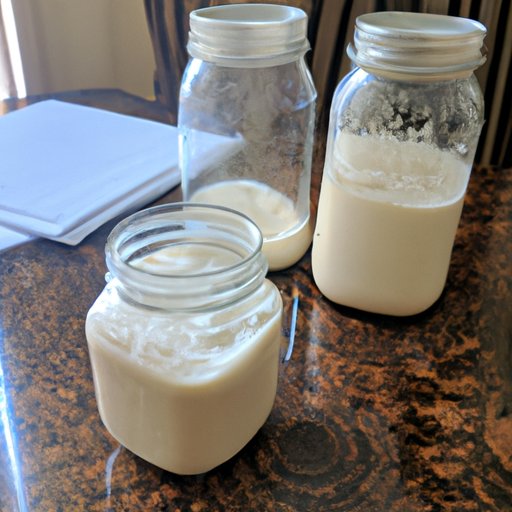
Introduction
Feeding your sourdough starter is a critical step in the sourdough bread baking process, as it is what provides the starter’s health and vitality. It is important to have knowledge about the type of flour and water that is used to feed your starter and how to take care of it. In this article, we will provide a comprehensive guide to help you feed your sourdough starter, troubleshoot common problems, and offer tips and tricks for optimal care.
A Step-by-Step Guide to Feeding Your Sourdough Starter
One of the essential steps in feeding your sourdough starter involves maintaining the right hydration level. The hydration level refers to the ratio between flour and water in your starter, which impacts the starter’s consistency.
Here’s a step-by-step guide to feeding your sourdough starter:
A. Choosing the Right Flour and Water
The type of flour that is used to feed your starter will impact its growth and flavor. Typically, unbleached all-purpose or bread flour works well. You can also use whole wheat or rye flour.
When selecting water, the goal is to avoid chlorine and other chemicals that can harm the natural fermentation process. For best results, use filtered or bottled water.
B. Mixing the Ingredients Together
It’s important to mix the starter thoroughly, ensuring that there are no dry pockets of flour or water. You should try to use a dough scraper that helps to ease this process.
C. Determining Feeding Schedules
Most sourdough bakers feed their starter once or twice every day. However, there is no exact formula that fits every starter. The frequency of feeding your sourdough starter will depend on environmental conditions and how you intend to use it. If you’re baking sourdough bread three times per week, you will need to maintain a higher feeding frequency than if you bake bread once a week.
Troubleshooting Common Problems When Feeding Your Sourdough Starter
Sourdough starter problems can be scary and frustrating, but fortunately, most can be fixed. If you find that your sourdough starter isn’t responding correctly, consider the following possible issues:
A. Mold Growth
If you spot gray or black fuzzy growth on top of your starter, it is mold. Remove it. Sterilize your container and utensils, then begin feeding the starter again. Change water, use unchlorinated water, or replace the vessel with a fresh one.
B. No Bubbles
Sourdough starters need to produce bubbles to grow and develop. A bubbly starter means that wild yeast is present and active. If there are no bubbles within four hours of being fed, the starter may be struggling. Try adjusting your feeding schedule, use warmer water, or change the room temperature.
C. Sour Smell
Sour-smelling sourdough starter is normal, but if the smell is overpowering, it could mean that you’ve allowed your starter to become too acidic. This is usually due to infrequent feeding or waiting too long to feed. Allow the starter to sit at room temperature for a few hours before placing/taking it back to the fridge.
The Science Behind Feeding Your Sourdough Starter
Are you interested in the science behind feeding your sourdough starter? The fundamental biological and chemical processes that produce the natural fermentation are present in sourdough starter too.
The wild yeast and bacteria interact with the flour and water to produce lactic and acetic acids. These acids act with enzymes to break down the complex carbohydrates in the flour into more manageable sugars that are both more digestible and simpler for the yeast and bacteria to eat.
How to Store and Use Sourdough Starter Leftovers
You don’t have to throw away sourdough starter before feeding it. Here are a few smart ideas for how to use it up:
– Adding the excess starter to pancake or waffle mix to add a slightly sour flavor
– Making sourdough crackers or flatbreads from excess starter.
– Store excess starter in the fridge and use it, whenever needed, by taking out a piece and feeding it one or two cycles before use.
Tips for Adjusting Your Sourdough Starter Feeding Schedule
When the temperature drops or rises, your starter feeding schedule can get a bit off balance, affecting your sourdough bread’s quality. Here are a few tips you can adopt:
– Adjust your sourdough starter feeding schedule as required to cater for seasonal fluctuations in temperature and humidity,
– Try switching to a larger or smaller container, depending on the volume of your sourdough starter.
Conclusion
We hope this comprehensive guide has helped you learn how to feed and care for your sourdough starter correctly. Remember, the key to maintaining a happy and healthy starter is to ensure that it’s fed and looked after regularly. It may take a few attempts to get perfect before you bake the perfect loaves of bread, but in the end, it’s worth it.




